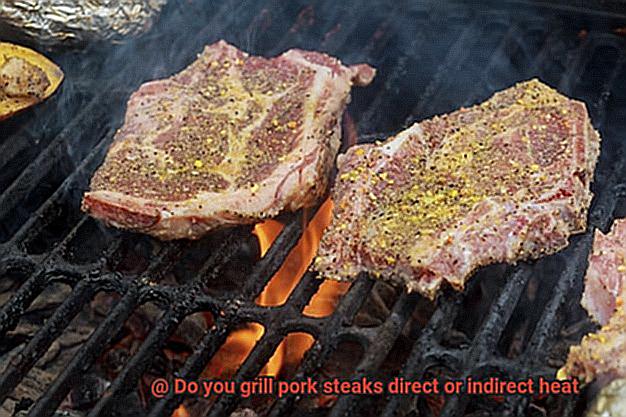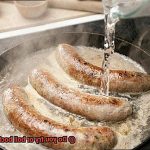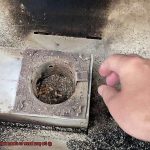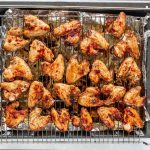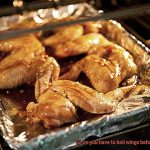Are you a grill master who can’t decide whether to apply direct or indirect heat when cooking pork steaks? Or perhaps you’re a newbie griller who wants to learn the difference between the two techniques? No matter your experience level, this article is here to guide you through the debate of direct vs. indirect heat for pork steaks.
If you’re a fan of juicy and succulent pork steaks, then you already know that cooking them to perfection can be quite tricky. Pork meat is delicate, and overcooking it can lead to dry and tough steaks. So how do you ensure that your pork steaks are cooked correctly?
The answer lies in the grilling technique – direct or indirect heat. Both methods have their advantages and disadvantages, so choosing which one to use depends on your preference.
In this article, we’ll delve into the pros and cons of each technique and provide insights on how to adjust your cooking method to get the perfect pork steaks. We’ll also address some frequently asked questions and share some grilling tips to make your pork steaks an absolute delight.
Grilling pork steaks with direct or indirect heat is a question that grill lovers often ask, but there’s no definitive answer. However, we will provide you with all the information you need to make an informed choice on your next pork steak grilling adventure.
Contents
What is Direct Heat?
Direct heat is a cooking technique that brings the heat source directly in contact with the food. This method is ideal for cooking thin cuts of meat, such as pork steaks, as it creates a sear on the outside while preserving the moisture and tenderness on the inside.
Not only is direct heat quick and easy, but it’s also versatile and can be achieved using various types of grills, including gas, charcoal, or electric. Gas grills offer the convenience of adjustable burners to control heat output, while charcoal grills add a unique smoky flavor to the meat. Regardless of the type of grill used, preheating it before cooking on it is essential to ensure even cooking and prevent dryness.
However, when using direct heat, one must keep an eye on the food to prevent burning. Flipping the meat every few minutes ensures even cooking and prevents it from sticking to the grill grates. It’s also crucial to choose foods that cook quickly and are not too thick, such as pork steaks.
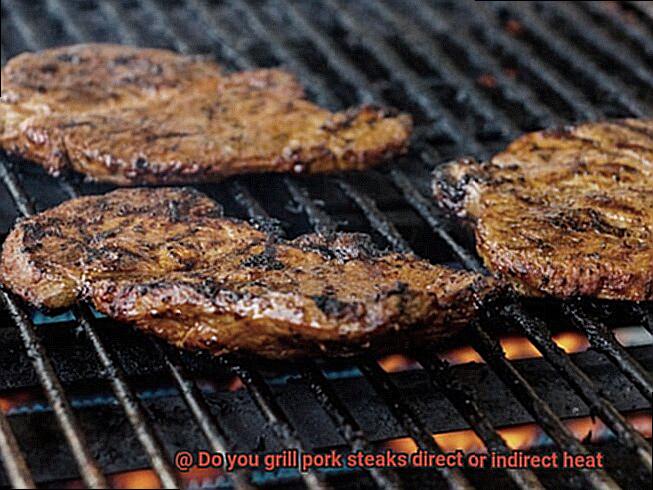
Direct heat is ideal for busy weeknights when time is limited but still want to make a delicious meal. It’s also perfect for outdoor grilling during summer months. With direct heat, you can achieve deliciously juicy pork steaks or other thin cuts of meats that are sure to impress your guests.
What is Indirect Heat?
Fear not, because indirect heat is here to save the day. Indirect heat is a cooking technique that involves using heat that doesn’t come directly from the flames or heat source. This method is particularly useful for delicate foods that may burn easily or for foods that require longer cooking times.
Indirect heat grilling is an excellent way to cook pork steaks to perfection. By placing the meat away from the direct heat source and closing the lid of the grill, you create an oven-like environment where hot air circulates around the meat. This slow and even cooking process results in juicy, tender pork steaks that will leave your taste buds singing with joy.
So, how do you achieve indirect heat? There are several ways to do this depending on what type of grill you have. For example, if you’re using a charcoal grill, set up a two-zone fire by placing charcoal on one side of the grill and leaving the other side empty. On the other hand, if you’re using a gas grill, simply turn off one burner. It’s important to maintain a consistent temperature throughout the cooking process to ensure even cooking. A meat thermometer can also be used to check the internal temperature of the pork steaks to make sure they’re fully cooked.
In summary, using indirect heat is an easy technique that can elevate your grilling game to new heights. Here’s a quick recap of why:
- Indirect heat allows for slow and even cooking, resulting in juicy and tender pork steaks.
- There are several ways to achieve indirect heat depending on what type of grill you have.
- Maintaining consistent temperature throughout the cooking process is crucial.
- A meat thermometer can be used to check if the pork steaks are fully cooked.
Factors to Consider When Grilling Pork Steaks
There are several factors to take into consideration before you light up the grill. As an expert in this field, let me guide you through the process.
Firstly, the thickness of your pork steak is key. If your cut is thick, it will require more time to cook through. In this case, indirect heat might be necessary to guarantee that the center is fully cooked without burning the outside. Nobody wants to end up with a charred exterior and raw meat inside.
Secondly, you should consider the level of char or crust you want on the outside of your pork steak. Direct heat is perfect for achieving a crispy exterior with those beautiful grill marks we all love. However, if you prefer a softer, less charred surface, then indirect heat is the way to go.
Thirdly, think about what type of grill you’ll be using. Gas grills are well-suited for both direct and indirect grilling since they usually have consistent heat and make temperature control easy. On the other hand, charcoal grills require more finesse and attention to temperature but can impart a smoky flavor that is highly desirable when grilling pork.
Finally, don’t forget about seasoning and marinades. Certain ingredients like sugar or honey can burn quickly over direct heat, resulting in an unpleasant taste. To prevent this issue, indirect grilling allows the pork to cook more slowly and evenly.
The Benefits of Direct Heat for Thin Cuts of Pork Steaks
This method involves placing the meat directly over the flame or hot coals, resulting in a juicy and tender interior with a perfectly caramelized exterior.
One significant advantage of using direct heat is its efficiency. Thin cuts of pork steaks, such as butterfly chops or boneless pork loin chops, cook quickly and can dry out if left on the grill for too long. Direct heat helps to avoid this problem by cooking the meat faster, ensuring that it stays moist and flavorful.
But that’s not all – direct heat also gives you greater control over the cooking process. With indirect heat, you’re at the mercy of the grill’s hot air. But with direct heat, you can adjust the heat source and move your meat around on the grill to ensure even cooking. This is especially important when dealing with thin cuts of meat as they can cook unevenly if not monitored properly.
And let’s not forget about the mouthwatering sear that direct heat creates on the outside of your pork steak. The high temperature causes the natural sugars in the meat to caramelize, creating a crispy crust that seals in all those juicy flavors. It’s visually appealing and enhances both the flavor and texture of your meat.
To sum it up, using direct heat for thin cuts of pork steaks is an excellent choice for achieving a perfectly cooked meal in less time. Benefits include faster cooking times, more control over the cooking process, and a beautiful sear on the outside of your meat. Just be sure to keep a close eye on your pork while it’s grilling to prevent overcooking and drying out.
The Benefits of Indirect Heat for Thick Cuts of Pork Steaks
As an expert in all things grilling, I can tell you that using indirect heat when cooking your thick cuts of pork steaks can result in a juicy and perfectly cooked end product.
Firstly, direct heat can cause the outside of your steak to become charred and dry while the inside remains undercooked. But by using indirect heat, the steak cooks more evenly, ensuring that the inside is cooked to perfection while the outside stays juicy and flavorful. This method also allows for a longer cooking time, which is necessary for thicker cuts of meat.
What’s more, using indirect heat also allows for the addition of wood chips or other flavor enhancers such as herbs or spices. These can be added to the grill or smoker to infuse your pork steak with additional flavor that will make your taste buds dance with delight. Imagine biting into a succulent pork steak infused with smoky flavors from hickory wood chips.
And let’s not forget about flare-ups. When grilling with direct heat, the fat from your pork steak can drip onto the flames, causing flare-ups that can char the meat and create an unpleasant taste. Indirect heat eliminates this risk by allowing for a more controlled cooking environment. You won’t have to worry about burnt pieces ruining your delicious meal.
Preheating the Grill Before Placing the Meat On It
Are you ready to take your pork steaks to the next level? Then listen up, because preheating your grill is a game-changer. It’s not just a minor detail – it’s a critical step that can make or break your grilling experience. Here’s why.
To start with, preheating your grill is all about achieving the right temperature. You need to give it at least 10-15 minutes to heat up properly. This step is crucial because it allows you to sear and caramelize the surface of your pork steaks, creating a mouthwatering crust and juicy interior. Who doesn’t love sinking their teeth into a perfectly seared pork steak?
But preheating your grill isn’t just about flavor – it’s also about practicality. Cold meat on a cold grill is a recipe for disaster, as it tends to stick and makes flipping or moving around a nightmare. By preheating your grill, you create a non-stick surface that makes it easy to cook your pork steaks evenly. No more struggling with stuck meat – just smooth grilling all the way.
And let’s not forget consistency. If you don’t preheat your grill, you risk temperature fluctuations that can lead to uneven cooking. That’s not what you want when you’re aiming for perfectly cooked pork steaks. By preheating, you ensure that the temperature stays constant throughout the cooking process, guaranteeing succulent results every time.
To get started, turn on your grill and close the lid, letting it reach the desired temperature range of 350-400°F. Once you hit that sweet spot, you’re ready to work your magic. Make sure to keep an eye on your pork steaks as they cook, and use a meat thermometer if needed.
How to Grill Using Direct and Indirect Heat
Grilling pork steaks is an art that requires not only the right technique but also knowledge about the different types of heat sources used in grilling.
One of the most important decisions you need to make when grilling pork steaks is whether to use direct or indirect heat.
This article will guide you through the process of grilling pork steaks using both direct and indirect heat.
Choosing the Right Heat
The choice between direct and indirect heat depends on several factors, including the thickness and size of the pork steak and personal preference. For thin cuts of pork steaks, such as boneless pork chops, direct heat is ideal. Direct heat involves placing the meat directly over the heat source and cooking it for a short period. The high heat sears the meat and creates a crispy outer layer while keeping the inside moist and juicy.
On the other hand, thicker cuts of pork steaks, such as bone-in pork chops or pork shoulder steaks, benefit from using indirect heat. Indirect heat involves placing the meat next to, but not directly over, the heat source and cooking it at a lower temperature for a more extended period. Indirect heat allows for slow cooking, resulting in tender and succulent meat.
Preparing Your Pork Steaks
Before grilling your pork steaks, there are a few things you need to do to ensure they cook evenly and taste great. First, remove any excess fat from the meat to prevent flare-ups when grilling. Then, season your pork steaks with your favorite spices or marinade for added flavor.
Grilling Pork Steaks Using Direct Heat
For thin cuts of pork steaks (around 1 inch or less), direct heat is usually the best option. Preheat your grill to high heat for 10-15 minutes before brushing some oil on your pork steaks and placing them directly over the heat source.
Grill for around 3-4 minutes on each side, flipping once, until the internal temperature reaches 145°F (63°C). Be sure to monitor the cooking process carefully as thinner steaks can easily overcook and become dry.
Grilling Pork Steaks Using Indirect Heat
For thicker pork steaks (over 1 inch), indirect heat is often a better choice. Start by building a two-zone fire in your grill by placing all of the coals on one side of the grill and leaving the other side empty. Once the coals are hot, place your pork steaks on the cool side of the grill, opposite the coals.
Close the lid and let them cook for around 30-40 minutes, flipping once, until they reach an internal temperature of 145°F (63°C). Indirect heat allows for slower cooking, ensuring that the inside of the steak cooks evenly without drying out.
f0WSPuKmj84″ >
Conclusion
In the end, the age-old question of whether to use direct or indirect heat when grilling pork steaks is a matter of personal taste and thickness. Thin cuts benefit from direct heat, which sears the outside while retaining moisture inside. Thick cuts require indirect heat for slow, even cooking that produces tender, juicy meat.
To ensure your pork steaks are mouthwatering, it’s important to remove excess fat and add your preferred seasonings or marinade. Preheating your grill also helps create a tantalizing crust while maintaining consistent temperatures throughout cooking.
Don’t let the thought of using direct or indirect heat intimidate you – with these tips in mind, anyone can achieve perfectly cooked meat every time. Whether you’re an experienced grill master or just starting out, don’t be afraid to experiment with both methods until you find what works best for you.

